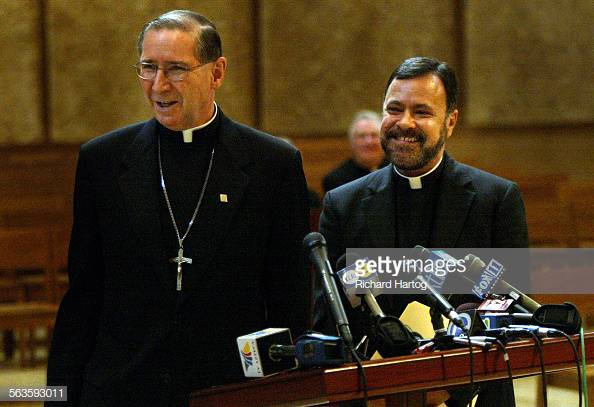Yesterday morning the Vatican announced that Pope Francis has accepted the resignation of Alexander Salazar, an auxiliary bishop of Los Angeles. In an open letter to his archdiocese, L.A.’s Archbishop José Gόmez explained that Bishop Salazar had been accused of “misconduct with a minor.”
According to Gόmez’s letter, “the allegation was never directly reported to the Archdiocese,” but the L.A. Archdiocese was made aware of the allegation in 2005.
The timeline is important here:
- The alleged misconduct by Salazar – who has consistently denied the allegations – occurred in the 1990s, before he was a bishop. Local law enforcement officials investigated the allegation in 2002 but declined to prosecute the case. Salazar (who had previously served as vice-chancellor under then-Archbishop of Los Angeles, Cardinal Roger Mahony) was made an auxiliary bishop of Los Angeles in 2004. The archdiocese was “made aware” of the allegation against Salazar sometime in 2005.
- Archbishop Gόmez replaced Cardinal Mahony as Archbishop in 2010.
- At some point between 2005 and 2010, the allegation against Salazar was referred to the Congregation for the Doctrine of the Faith. We have no indication of precisely when the Salazar case was referred to the CDF, but by May of 2005, the new Prefect for the Congregation of the Doctrine of the Faith – the man Joseph Ratzinger had chosen as his own replacement upon being elected Pope Benedict XVI – was Cardinal William Levada.
- Levada was himself a former auxiliary bishop of Los Angeles under Cardinal Mahony. And a seminary classmate of Mahony’s. And had served as chancellor of the Archdiocese and moderator of the Curia under Mahony. Levada’s CDF decided to impose, as Archbishop Gόmez put it in his letter, “certain precautionary measures on the ministry of Bishop Salazar.”
To sum up: Cardinal Mahony reported an allegation against his auxiliary and former vice-chancellor (Salazar) to the CDF where Mahony’s former classmate/auxiliary/chancellor/ moderator (Levada) investigated said allegation. The result of that investigation was a private slap on the wrist for Salazar.
Presumably, that would have been the end of the matter if Archbishop Gόmez hadn’t decided to take up the matter when he became Archbishop of Los Angeles. Gόmez asked and received permission from the Congregation for Bishops to present Salazar’s case to his archdiocesan review board. It was on the basis of the review board’s findings – and alongside Archbishop Gόmez’s recommendation – that the Holy See decided to remove Salazar.

Set aside Cardinal Mahony’s notorious record of grossly mishandling sexual abuse claims; assume for the moment that Cardinal Levada was scrupulous in handling the investigation in 2005; consider that Bishop Salazar denies the allegation against him and that law enforcement declined to prosecute the allegation when it was made. Even given all that, the handling of the initial allegation against Salazar reeks of a conflict of interests and the appearance of favoritism.
The Salazar case is a textbook example of the need for independent, lay involvement in the review of allegations of sexual misconduct against bishops. Whether that should be done through the establishment of a national board for the review of charges of episcopal misconduct or through the use of existing diocesan review boards (the so-called “metropolitan model”) is a matter of debate, as we saw last month in Baltimore. But the bishops simply lack the credibility to police their own ranks without outside help.
Lay review boards aren’t a panacea. They can’t reform seminaries or solve the festering problem of priests who flout the demands of chastity. They don’t choose new bishops. They won’t heal old wounds. But they can be a down payment toward restoring the credibility of an episcopate that desperately needs to get its reputation out of the red. The Church, and the world to which she is bound to proclaim the Good News, needs trustworthy shepherds.
As for the authority to remove a bishop, that resides with the pope; no amount of lay involvement or review is going to change that. But as the Salazar case demonstrates, adding a layer of accountability and review outside the close-knit circles of higher ecclesial office helps break the stranglehold of a clerical caste which, occasionally (and by their own admission), functions more like a Good Old Boys Club than the college of the successors to the apostles.
Even if Rome stymied the USCCB plans to vote on lay-led review procedures at last month’s annual meeting, the Salazar case shows that such system is actually already working on an ad hoc basis and, critically, with Rome’s cooperation.
Bishop John Jenik, auxiliary of New York, stepped aside from ministry after New York’s lay review board found a decades-old allegation against him to be “credible and substantiated.” (Bishop Jenik denies the allegation.)
Of course, one of the allegations against Archbishop McCarrick also passed through New York’s review board and ultimately led to his removal from ministry and the College of Cardinals by Pope Francis. Now, add Bishop Salazar to the list.
It has become something of a refrain in my thinking and writing about the abuse crisis that, if genuine reform is to come, it will come with and through the successor of Peter and the bishops in communion with him – because without them there is no Church to be reformed. But that doesn’t mean that the way forward will be cooked up, all at once, in Rome or Baltimore.
It’s not as dramatic as a Grand New Ecclesial Strategy, but the beginnings of a workable, credible way to handle allegations of misconduct by bishops – one which respects both the authority of the episcopal office and the unique primacy of Peter – are already coming into shape, piecemeal, but organically. Or, if you like, Providentially.
Let us hope that the leaders of the world’s episcopal conferences, who will meet in Rome with Pope Francis in February to discuss the crisis, will take note.















